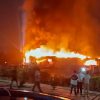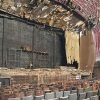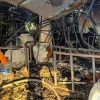Goa is abuzz with excitement as vintage bike and car owners, users, collectors and fans are decking […]

REMEMBERING THE BABRI MASJID
INFOCUS, Oct 05- Oct 11 2019 October 4, 2019As the day of the Babri Masjid judgment (as it is called) draws near, we take a walk down memory lane.Who is truly responsible for the destruction of the masjid? The list includes the patriarch of the BJP LK Advani, the then CM of the state Kalyan Singh, and ironically the then Congress PM P V Narasimha Rao, who stayed silent even as the kar sevaks destroyed the dome of the mosque…
BY NIKITA DOVAL
L.K. Advani — Then: BJP president; Now: Retired
It was 1990 and the Bharatiya Janata Party (BJP) was hoping to expand its footprint nationally. In the 1984 general elections the party had won only two seats in the Lok Sabha; by 1989, the party had won over 80 seats. L.K. Advani, party president from 1989, undertook a rath yatra, which is considered directly responsible for two outcomes—the demolition of Babri Masjid on 6 December 1992 and the rise of the BJP to power. The rath (an air conditioned van re-fashioned to look like a chariot) was meant to mobilize people to converge upon Babri Masjid and began in Somnath, Gujarat.
It was meant to culminate in Ayodhya but was stopped by Lalu Prasad Yadav, the then chief minister of Bihar, who ordered Advani arrested. But it had served its purpose: the BJP crossed the 100 mark in the 1991 Lok Sabha elections. When the mosque was brought down on 6 December 1992, Advani, along with other BJP leaders, was present in Ayodhya, giving speeches to crowds of kar sevaks.
In 1996, BJP emerged as the single largest party in Lok Sabha and formed a short-lived government at the centre for 13 days. In 1998, the party came to power again as part of the National Democratic Alliance with Advani as home minister. He was later elevated to deputy Prime Minister. But BJP lost the 2004 and 2009 general elections, with Advani projected as its PM candidate in both. As Narendra Modi rose to prominence, Advani found himself sidelined in the party.
Current status: Retired as a senior leader of the party and doesn’t have much of a role to play any longer.
Kalyan Singh — Then: Chief minister of Uttar Pradesh; Now: Governor of Rajasthan
It was the Uttar Pradesh chief minister’s duty to ensure the safety of the Babri Masjid, irrespective of his ideological leanings. But Singh’s reputation is forever sullied by the misleading statements he made in the run-up to 6 December. From written assurances to speeches in the assembly, he insisted his government would provide security to the disputed structure. Singh even submitted a four-point affidavit to the Supreme Court promising security of the mosque and assuring that only a symbolic kar seva would be allowed.
Current status: Singh resigned within hours of the Babri Masjid being demolished. He served as the UP chief minister again from September 1997 to November 1999, quit the BJP in 1999 and rejoined it in 2004. He left the party again in 2009 and joined the Samajwadi Party. In 2010, he formed a new party the Jan Kranti Party but dissolved it in 2013 before returning to the BJP. He is currently the governor of Rajasthan
P.V. Narasimha Rao — Then: Prime minister of India; Now: He died in 2004
As the prime minister, the buck for the demolition of the Babri Masjid stopped with P.V. Narasimha Rao. The act occurred on his watch and that too despite signs that it was inevitable.
Rao was the 9th Prime Minister, whose tenure saw India’s economy liberalized. Yet his legacy is destined to be tainted by the demolition. There have been tell-all books—from his physician, media adviser, senior journalists and even former President Pranab Mukherjee—who have tried to piece together this curious case of inaction in the face of an impending threat.
It is believed Rao had the option to impose central rule in Uttar Pradesh in July and had even sought a contingency plan to protect the mosque. But eventually he did nothing. The Vishwa Hindu Parishad’s announcement in October of plans to perform a kar seva next to the Babri Masjid on 6 December 1990 led Rao to ask his home secretary Madhav Godbole to come up with a contingency plan. Several meetings between different players were to follow over the following days.
Kalyan Singh, then chief minister of Uttar Pradesh, assured the Supreme Court that the mosque would be protected while Rao agonized over the question of dismissing the state government. Several theories have done the rounds over the years of what Rao was doing as the mosque was first overrun and then brought down by the kar sevaks and just why was this allowed to happen. History is tight-lipped on this, just as Rao himself was.
Current status: Rao passed away in 2004.
Lalu Prasad — Then: Chief minister of Bihar; Now: President of Rashtriya Janata Dal
On 23 October, even as L.K. Advani’s rath yatra wound its way through Bihar, one man stood up to stop its progress. Bihar chief minister Lalu Prasad ordered Advani’s arrest in Samastipur on grounds of creating communal disharmony. In an interview to Frontline magazine in 1990, Prasad said he would have given his life to preserve communal amity and that he alone ordered the arrest.
Current status: Numerous graft cases against him may have dimmed his aura but Prasad remains a force in Indian politics, and is particularly strong when it comes to upholding secular values.
Uma Bharti — Then: BJP leader; Now: Union minister of drinking water and sanitation
Bharti owes her rise to the Ram Janmabhoomi movement, and was one of the Bharatiya Janata Party (BJP) leaders present at the rally in Ayodhya during which the Babri Masjid was demolished. The Liberhan Commission, set up to probe the events of that day, indicted her for inciting a mob to violence. Bharti, a firebrand politician, said she took moral responsibility for the incident but added that she will fight the indictment legally as she had no hand in the destruction of the mosque.
Current status: From Madhya Pradesh chief minister (2003-2004) to being expelled from BJP to returning to the party as a Union minister, Bharti’s political career has seen many ups and downs since 6 December. She is currently Union minister of drinking water and sanitation.
Ashok Singhal — Then: Chief of Vishwa Hindu Parishad; Now: He died in 2015
Often called the architect of the Ram Mandir movement, Vishwa Hindu Parishad chief Ashok Singhal was one of the most important public figures from the Sangh Parivar—a man who shot into the limelight in the 1980s on the back of the Ayodhya movement.
Singhal launched the Ram Janaki Rath Yatra in 1984 and demanded that locks be opened up at the Babri Masjid gates. Considered close to both L.K. Advani and Atal Bihari Vajpayee, he was present in Ayodhya on 6 December. He was disenchanted with Vajpayee after the National Democratic Alliance government under him put the Ram Janmabhoomi issue on the back burner post 1998.
Current status: Singhal died in 2015.
Courtesy: Livemint















